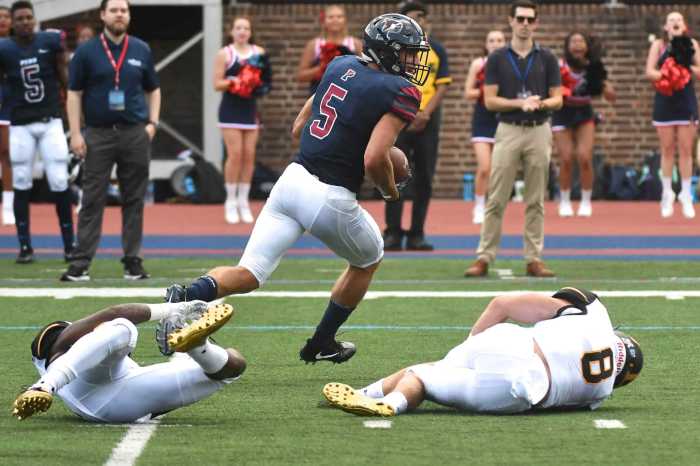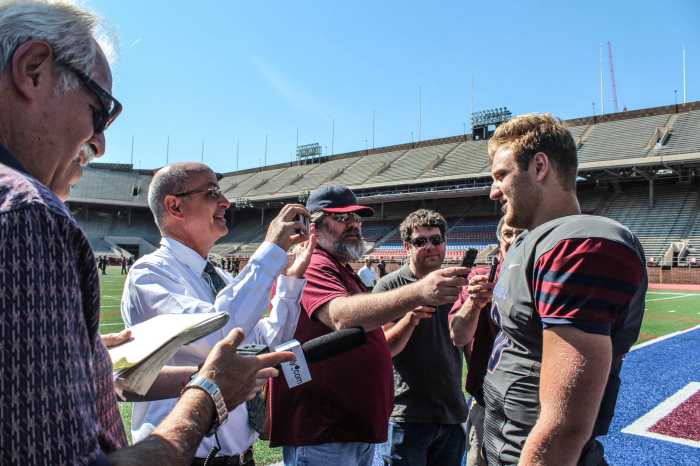Just how big a deal are the Penn Relays,(especially for local teams)?Consider the words of Marcus O’Sullivan; who not only ran for Villanova in the early 80’s before taking over as coach 17 years ago, but for the Irish Olympic team as well. “I equate the stress here to what I had in the Olympic games,”said O’Sullivan, a four-time Olympian, who’ll bring a strong relay contingent to Franklin Field, where he expects Oregon and Penn State to be his chief competition. “This meet has defined me as a person.This is where I learned to be accountable. It’s important for us to understand as team, the buck stops here. This is where they get judged on.” The “judging” actually got underway Tuesday with the start of the decathlon and women’s heptathlon.It will only continue to heat up through the weekend, as literally thousands of runners make their way through the paddock area onto the track. For those who’ve never been here before or even those who make it an annual ritual, it doesn’t take long to realize the Relays are different.
“I can remember standing under the rail with my coach,”recalled Relays Director, Dave Johnson, thinking back to his days as a highschool runner. “The biggest meet I’d been to was the Chichester Relays which had 400 people. So to come here to see a track meet with thousands of people enjoying the sport at this level was enthralling.It’s just an amazing place.” Little has changed in terms of the layout and vast numbers who come to Philadelphia each year to compete the last weekend in April.Back then, not as many of the national powers, like LSU, Tennessee, Texas A&M, Stanford and Oregon would make the trek East. Now they wouldn’t miss it.
“I’m sitting in my office with three Penn Relays wheels (presented to the winning relay teams)on the wall,”said Stanford’sChris Miltenberg who previously coach at Georgetown. “We take it really seriously.In California you fall into a trap. All our meets are in perfect weather and the rabbits (pace setters)are all set up.That’s not reflective of championship races.The Penn Relays are the ultimate `take the stick and go for it.’ race. Coming back to Penn helps prepare us for the rest of the year.” One thing about running here, anything can happen.First, it’s making your way though the paddock area, where the officials line runners up like cattle, send them off, then bring in the next group.Then, it’s making sure you hold onto the baton amid the jostling and roars of the crowd who might actually be cheering a high jumper who cleared the bar as much as the race going on.And finally, you can’t be intimidated by the names on the other jerseys. Much easier said than done.
“If you can maintain your concentration and focus at the Penn Relays it makes it that much easier when you get in pressure situations like conference championships and the NCAAs,”said LSU coach Dennis Shaver, whose men’s and women’s sprint teams figure to duel with Texas A&M for top honors. “Obviously there’s a million things going on and a million excuses for being distracted.I think it’s a great experience for the kids.” Not only American kids, either, ever since Jamaican high schools started sending their top runners to the Relays over 50 years ago.Look into the stands and you’ll see those distinctive green, black and gold flags waving at the sight of Calabar, Kingston, St. Jago, Vere Tech and many others. Yes, Usain Bolt ran here. So don’t be surprised if it turns out the next Usain Bolt is running here this weekend.
But one thing you won’t find is the cherry and white among the men.While the women’s team remains, other than fielding a club team in the 4×100 Olympic Development relay, Temple men will be a no-show at the Relays.Men’s track and field became one of the casualties when the school voted to drop seven sports in December, 2013.This will be the first time the Relays goes on without them. Even without them, though, there’s so much else going on.
“For people who’ve never been here before,”said Dave Johnson, “it’s a mind-boggling experience.’’
All right here in our own backyard.
Penn Relays: Philly’s annual race is special to athletes all over the world

Getty Images


























